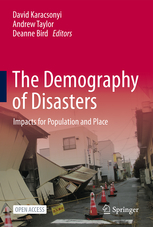External publications

Migration as a potential heat stress adaptation strategy in Australia
Zander, Kerstin K / Carmen Richerzhagen / Stephen T. GarnettExternal Publications (2020)
in: David Karacsonyi / Andrew Taylor / Deanne Bird (eds.), The demography of disasters: impacts for population and place, Heidelberg: Springer Verlag, 153-167
ISBN: 978-3-030-49920-4
DOI: https://doi.org/10.1007/978-3-030-49920-4_8
Information
As the climate changes, natural disasters are becoming more frequent and severe. Some disasters are sudden and briefly devastating. Research shows that, in response, many people emigrate temporarily but return when the danger is past. The effect of slow-onset disasters can be equally disruptive but the economic and social impacts can last much longer. In Australia, extreme heat and the rising frequency of heat waves is a slow-onset disaster even if individual periods of hot weather are brief. This chapter investigates the impact of increasing heat stress on the intention of people living in Australia to migrate to cooler places as an adaptation strategy using an online survey of 1344 people. About 73% felt stressed by increasing heat of which 11% expressed an intention to move to cooler places in response. The more affected people had been by the heat, the more likely they were to intend to move. Tasmania was a preferred destination (20% of those intending to move), although many people (38%) were unsure where they would go. As Australia becomes hotter, heat can be expected to play a greater role in people’s mobility decisions. Knowing the source and destination of this flow of internal migrants will be critical to planning and policy-making.
Contact
Cornelia Hornschild
Publication Coordinator
E-mail Cornelia.Hornschild@idos-research.de
Phone +49 (0)228 94927-135
Fax +49 (0)228 94927-130
Alexandra Fante
Librarian/ Open Access Coordinator
E-Mail Alexandra.Fante@idos-research.de
Telefon +49 (0)228 94927-321
Fax +49 (0)228 94927-130


![[Translate to English:] Photo: Alexandra Fante, Bibliothekarin/Open Access-Koordinatorin](/fileadmin/_processed_/f/0/csm__c_Deutsches-Institut-fuer-Entwicklungspolitik_Fante_94ce4fa1ba.jpg)